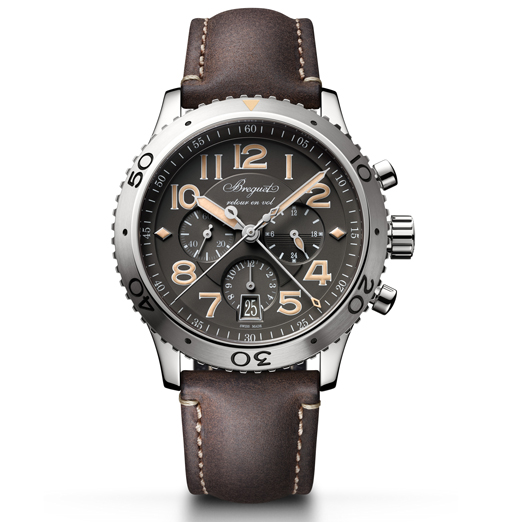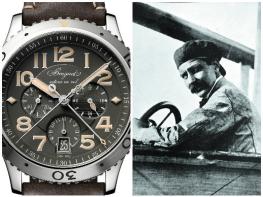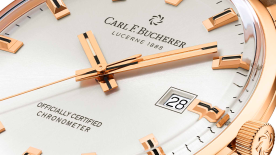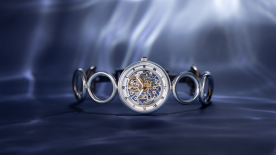Just two journalists were invited to the event, which took place at a military base in Evreux, France. The purpose of the visit was to mark the launch of the new Type XXI and the unveiling of a replica Breguet 14 aircraft. And therein lies a strange paradox. These days, watchmaking enthusiasts are familiar with the Type XXI chronograph, but know very little of the history that makes it so special.
In recognition of this phenomenon, Breguet decided to let history speak for itself. Breguet’s history, but also History, with a capital H. Louis Breguet played a significant part in both. After the Breguet family had given up its eponymous watchmaking concern, Louis entered the world of aviation, becoming one of the defining aviators of the 20th century.
Une histoire enfin dévoilée
History uncovered
Breguet has never fully engaged with this aerial chapter in its history – until now. It has focused on watchmaking, and left the rest of the family history largely alone. And it’s easy to see why: a glance at the Breguet family’s aeronautical pedigree is enough to make anyone feel dizzy. Louis Breguet (1880–1955) represented the family’s fifth generation since Abraham-Louis, who founded the eponymous watch manufacture. In 1900, he did his military service in Evreux. It was there that first came into contact with aviation, but he subsequently moved to Douai, where the family had an engineering firm.
Breguet – inventor of the helicopter
Not many people know this, but it wasn’t long before Louis Breguet came up with his first revolutionary idea: the gyroplane. The engineer realised that aircraft were considerably limited by take-off and landing distances, a problem he solved with a gyroplane that had vertical take-off capability. The rest is... history. Throughout the two World Wars, take-off and landing speed proved to be decisive factors, and Louis Breguet’s gyroplane, a prototype of which was built in 1907, became the helicopter.

Breguet and his beetroots
Nevertheless, it was aeroplanes that were to be Louis Breguet’s chief occupation for the next fifty years. In 1907 he began flying his own biplanes over the beetroot fields of northern France where his family lived, ploughing up quite a few vegetables during his manoeuvres. Locals affectionately called him the “beetroot puller”, little realising that they were witnessing the birth of a global phenomenon.
Indeed, Louis Breguet had already grasped the potential of aviation. He was the man who, in 1909, understood that he had to rally public opinion to his cause, and convened one of the first aeroplane rallies in history, in Douai. A certain Louis Blériot was in attendance. The French military got wind of the event, and ordered its first planes from him. Louis Breguet, a visionary industrialist, seized the opportunity. In 1911 he set the world air speed record, first with one passenger, then with two. But it wasn’t just about breaking records: Louis Breguet was laying the foundations for commercial aviation.
1914-1918: the turning point
The 1914-1918 war accelerated the course of events. Breguet saw his military orders go through the roof. His bombers and reconnaissance planes were instrumental in the Allied victory. He joined forces with Michelin, Canton-Unné, Hispano, Farman, Gnome & Rhône and other manufacturers. Breguet biplanes flew at the record altitude of 6000 metres, which meant they were able to escape enemy fire.
The first long-distance routes were established: Istanbul, Bucharest, then Tokyo and Manila. Along the way, Breguet developed a formula for calculating an aircraft’s range that is still used today. It’s known as the Breguet range equation.
Orders for the Breguet 14, the company’s flagship plane, were received from countries as far afield as the United States, Brazil, Belgium, Denmark, Sweden, Poland and Spain. In 1918, Breguet even produced one of the world’s first monoplanes, in association with the Eiffel laboratory.
The beginnings of Air France and Airbus
1918 saw a brief return to peace, and Breguet turned his attention back to commercial aviation. He created Air Union, which would later evolve into Air France. In 1930 Louis Breguet developed a steel-bodied three-engine plane that could carry ten passengers.
Louis Breguet’s company continued to build on these foundations, innovating and increasing passenger capacity, tonnage, speed, altitude and power. The pioneer even went so far as to invent a double-decker plane, the Breguet 760, anticipating the Airbus A380 by 40 years. Airbus was a European company based on an economic model that Breguet also anticipated in 1959, when he produced the 1150 Atlantic aircraft in a cooperative venture between France, Belgium, Germany and the Netherlands. Louis Breguet’s imagination led him to design hydroplanes, sport planes and even electric cars before his death in 1955.
It is impossible to do justice to his epic life and incredible achievements, but his spirit has been captured sensitively and subtly in the Breguet’s Type XXI. This is what makes it not just another aviation chronograph, but the noble heir to a phenomenal aeronautical legacy.






